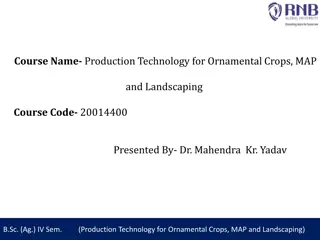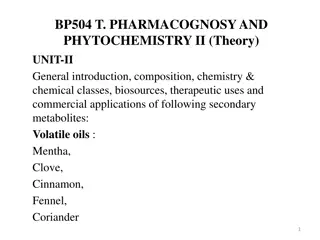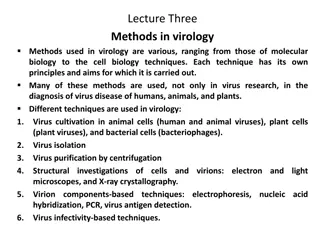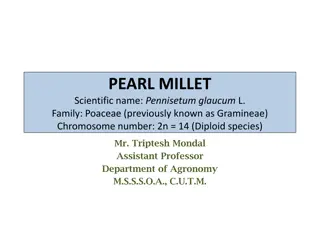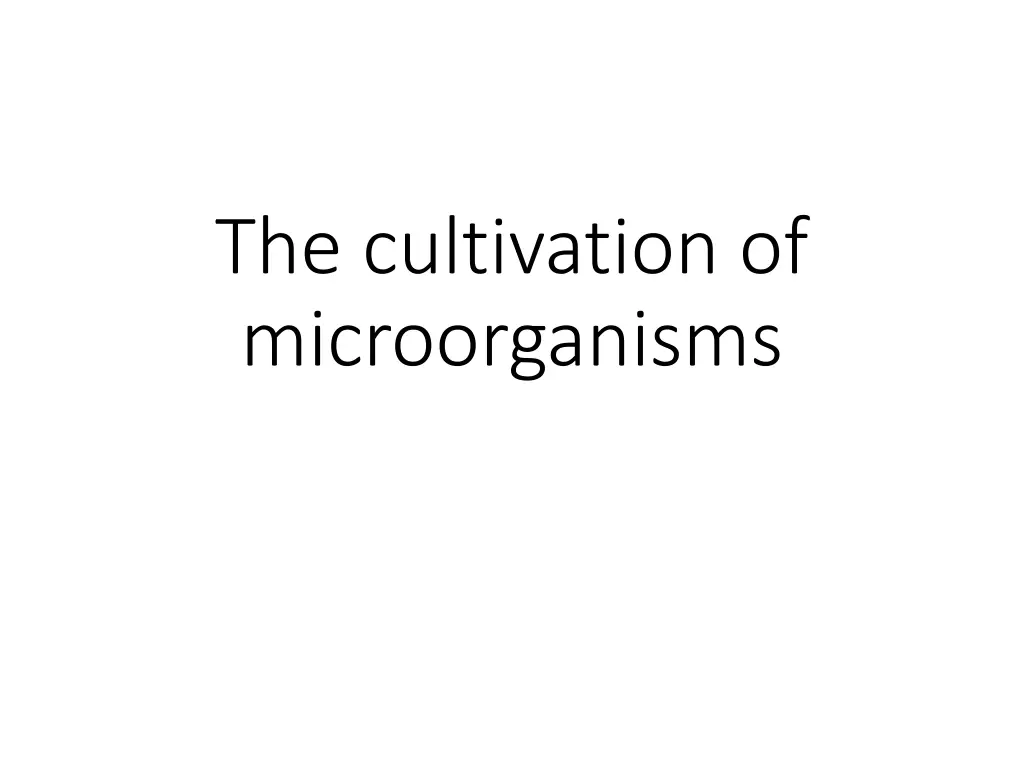
Microbial Growth Requirements and Cultivation Explained
Discover the essential chemical and physical requirements for cultivating microorganisms, including the importance of water, mineral elements, and gas. Explore how microorganisms obtain carbon, nitrogen, and phosphorus for growth, along with the role of oxygen in aerobic and anaerobic metabolism. Learn about trace elements and organic growth factors necessary for microbial growth, as well as the influence of temperature on different types of microorganisms.
Download Presentation

Please find below an Image/Link to download the presentation.
The content on the website is provided AS IS for your information and personal use only. It may not be sold, licensed, or shared on other websites without obtaining consent from the author. If you encounter any issues during the download, it is possible that the publisher has removed the file from their server.
You are allowed to download the files provided on this website for personal or commercial use, subject to the condition that they are used lawfully. All files are the property of their respective owners.
The content on the website is provided AS IS for your information and personal use only. It may not be sold, licensed, or shared on other websites without obtaining consent from the author.
E N D
Presentation Transcript
The cultivation of microorganisms
Growth requirements for microorganisms Chemical requirements In order to grow successfully, microorganisms must have a supply of water as well as numerous other substances including mineral elements, growth factors, and gas, such as oxygen. Virtually all chemical substances in microorganisms contain carbon in some form, whether they be proteins, fats, carbohydrates, or lipids. Perhaps 50% of a bacterium's dry weight is carbon. Carbon can be obtained from organic materials in the environment, or it may be derived from carbon dioxide. Both chemoautotrophic and photoautotrophic microorganisms obtain their energy and produce their nutrients from simple inorganic compounds such as carbon dioxide. Chemoautotrophs do so through chemical reactions, while photoautotrophs use photosynthesis. Among the other elements required by microorganisms are nitrogen and phosphorous. Nitrogen is used for the synthesis of proteins, amino acids, DNA, and RNA. Bacteria that obtain nitrogen directly from the atmosphere are called nitrogen-fixing bacteria. They include species of Rhizobium and Azotobacter, both found in the soil. Phosphorus is an essential element for nucleic acid synthesis and for the construction of phospholipids.
Chemical requirements Chemical requirements Oxygen is used by aerobic bacteria during the process of cellular respiration as a final electron acceptor. For aerobic organisms, oxygen is an absolute requirement for their energy-yielding properties. Certain microorganisms grow in oxygen-free environments and are described as anaerobic. Organisms such as these produce odoriferous gases in their metabolism, including hydrogen sulfide gas and methane. Certain pathogenic species, such as Clostridium species, are anaerobic. Certain species of microorganisms are said to be facultative. These species grow in either the presence or absence of oxygen. Some bacteria species are microaerophilic, meaning that they grow in low concentrations of oxygen. In some cases, these organisms must have an environment rich in carbon dioxide. Organisms such as these are said to be capnophilic.
Chemical requirements Chemical requirements Other chemical requirements for microbial growth include such trace elements as iron, copper, and zinc. These elements often are used for the synthesis of enzymes. Organic growth factors such as vitamins may also be required by certain bacteria. Amino acids, purines, and pyrimidines should also be available.
Physical Physical requirements requirements Certain physical conditions affect the type and amount of microbial growth. For example, enzyme activity depends on the temperature of the environment, and microorganisms are classified in three groups according to their temperature preferences: psychrophilic organisms (psychrophiles) prefer cold temperatures of about 0 C to 20 C; mesophilic organisms (mesophiles) prefer temperatures at 20 C to 40 C; thermophilic organisms (thermophiles) prefer temperatures higher than 40 C. A minimum and a maximum growth temperature range exist for each species. The temperature at which best growth occurs is the optimum growth temperature.
Physical requirements Physical requirements Another physical requirement is the extent of acidity or alkalinity, referred to as the pH of a solution. For most bacteria, the optimum pH is between 6.5 and 7.5. Since the pH of most human tissue is 7.0 to 7.2, these neutrophilic bacteria usually grow well in the body. Certain bacteria, such as those in sauerkraut and yogurt, prefer acidic environments of 6.0 or below. These bacteria are said to be acidophilic. Molds and yeasts are among other common acidophilic microorganisms. Microbial growth proceeds best when the osmotic pressure is ideal. Normally, the salt concentration of microbial cytoplasm is about 1%. When the external environment also has a 1% salt concentration, then the osmotic pressure is optimum. Should the external salt concentration rise, as when food is salted, water will flow out of the microbial cytoplasm by osmosis through the cell membrane into the environment, thereby causing the microorganisms to shrink and die. By comparison, if exterior water is free of salt, it will flow through the cell membrane into the cytoplasm of the cell, causing the organism to swell and burst. Microorganisms that live in marine environments can tolerate high salt concentrations. These organisms are said to be halophilic. They include diatoms and dinoflagellates, two types of unicellular algae that lie at the base of oceanic food chains. There are many other species of halophilic bacteria, fungi, protozoa, and algae.
Microorganisms classification on energy Microorganisms classification on energy source and respiration type source and respiration type
Microbial Microbial Cultivation Cultivation When microorganisms are cultivated in the laboratory, a growth environment called a medium is used. The medium may be purely chemical (a chemically defined medium), or it may contain organic materials, or it may consist of living organisms such as fertilized eggs. Microorganisms growing in or on such a medium form a culture. A culture is considered a pure culture if only one type of organism is present and a mixed culture if populations of different organisms are present. When first used, the culture medium should be sterile, meaning that no form of life is present before inoculation with the microorganism.
General microbial media General microbial media For the cultivation of bacteria, a commonly used medium is nutrient broth, a liquid containing proteins, salts, and growth enhancers that will support many bacteria. To solidify the medium, an agent such as agar is added. Agar is a polysaccharide that adds no nutrients to a medium, but merely solidifies it. The medium that results is nutrient agar. Many media for microorganisms are complex, reflecting the growth requirements of the microorganisms. For instance, most fungi require extra carbohydrate and an acidic environment for optimal growth. The medium employed for these organisms is potato dextrose agar, also known as Sabouraud dextrose agar. For protozoa, liquid media are generally required, and for rickettsiae and viruses, living tissue cells must be provided for best cultivation.
Oxygen conditions Oxygen conditions To supply oxygen to aerobic bacteria, different methods of aeration of the culture medium can be used. These techniques are include stirring, shaking or aeration throw sparger. The additional aeration is commonly used in the case of deep cultivation of microorganisms. In surface cultivation, as a rule, additional oxygen supply is not required. For anaerobic microorganisms, the atmosphere must be oxygen free. To eliminate the oxygen, the culture media can be placed within containers where carbon dioxide and hydrogen gas are generated and oxygen is removed from the atmosphere. Commercially available products achieve these conditions. Anaerobic chambers can also be used within closed compartments, and technicians can manipulate culture media within these chambers. To encourage carbon dioxide formation, a candle can be burned to use up oxygen and replace it with carbon dioxide.
Special microbial Special microbial media media Certain microorganisms are cultivated in selective media. These media retard the growth of unwanted organisms while encouraging the growth of the organisms desired. For example, mannitol salt agar is selective for staphylococci because most other bacteria cannot grow in its high-salt environment. Another selective medium is brilliant green agar, a medium that inhibits Gram-positive bacteria while permitting Gram-negative organisms such as Salmonella species to grow. Still other culture media are differential media. These media provide environments in which different bacteria can be distinguished from one another. For instance, violet red bile agar is used to distinguish coliform bacteria such as Escherichia coli from noncoliform organisms. The coliform bacteria appear as bright pink colonies in this media, while noncoliforms appear a light pink or clear. Certain media are both selective and differential. For instance, MacConkey agar differentiates lactose-fermenting bacteria from nonlactose-fermenting bacteria while inhibiting the growth of Gram-positive bacteria. Since lactose-fermenting bacteria are often involved in water pollution, they can be distinguished by adding samples of water to MacConkey agar and waiting for growth to appear. In some cases, it is necessary to formulate an enriched medium. Such a medium provides specific nutrients that encourage selected species of microorganisms to flourish in a mixed sample. When attempting to isolate Salmonella species from fecal samples, for instance, it is helpful to place a sample of the material in an enriched medium to encourage Salmonella species to multiply before the isolation techniques begin.
In order to work with microorganisms in the laboratory, it is desirable to obtain them in pure cultures. Pure cultures of bacteria can be obtained by spreading bacteria out and permitting the individual cells to form masses of growth called colonies. One can then pick a sample from the colony and be assured that it contains only one kind of bacteria. Cultivating these bacteria on a separate medium will yield a pure culture. To preserve microbial cultures, they may be placed in the refrigerator to slow down the metabolism taking place. Two other methods are deep-freezing and freeze-drying. For deep-freezing, the microorganisms are placed in a liquid and frozen quickly at temperatures below 50 C. Freeze-drying (lyophilization) is performed in an apparatus that uses a vacuum to draw water off after the microbial suspension has been frozen. The culture resembles a powder, and the microorganisms can be preserved for long periods in this condition.
Isolation methods To obtain separated colonies from a mixed culture, variousisolation methods can be used. One is the streak plate method, in which a sample of mixed bacteria is streaked several times along one edge of a Petri dish containing a medium such as nutrient agar. A loop is flamed and then touched to the first area to retrieve a sample of bacteria. This sample is then streaked several times in the second area of the medium. The loop is then reflamed, touched to the second area, and streaked once again in the third area. The process can be repeated in a fourth and fifth area if desired. During incubation, the bacteria will multiply rapidly and form colonies. A second isolation method is the pour plate method. In this method, a sample of bacteria is diluted in several tubes of melted medium such as nutrient agar. After dilution, the melted agar is poured into separate Petri dishes and allowed to harden. Since the bacteria have been diluted in the various tubes, the plates will contain various dilutions of bacteria, and where the bacteria are most diluted, they will form isolated colonies. Figure 1
One of the remarkable attributes of bacteria is the relatively short generation time, the time required for a microbial population to double in numbers. The generation time varies among bacteria and often ranges between 30 minutes and three hours. Certain bacteria have very brief generation times. Escherichia coli, for example, has a generation time of about 20 minutes when it is dividing under optimal conditions.
Phases of culture growth Phases of culture growth (the growth curve) curve) the growth
The growth curve The growth curve The growth of a bacterial population can be expressed in various phases of a growth curve. The logarithms of the actual numbers in the population are plotted in the growth curve along the side axis, and the time is plotted at the base. Four phases of growth are recognized in the growth curve. In the first phase, called the lag phase, the population remains at the same number as the bacteria become accustomed to their new environment. Metabolic activity is taking place, and new cells are being produced to offset those that are dying. In the logarithmic phase, or log phase, bacterial growth occurs at its optimal level and the population doubles rapidly. This phase is represented by a straight line, and the population is at its metabolic peak. Research experiments are often performed at this time. During the next phase, the stationary phase, the reproduction of bacterial cells is offset by their death, and the population reaches a plateau. The reasons for bacterial death include the accumulation of waste, the lack of nutrients, and the unfavorable environmental conditions that may have developed. If the conditions are not altered, the population will enter its decline, or death phase (Figure 1 ). The bacteria die off rapidly, the curve turns downward, and the last cell in the population soon dies.






